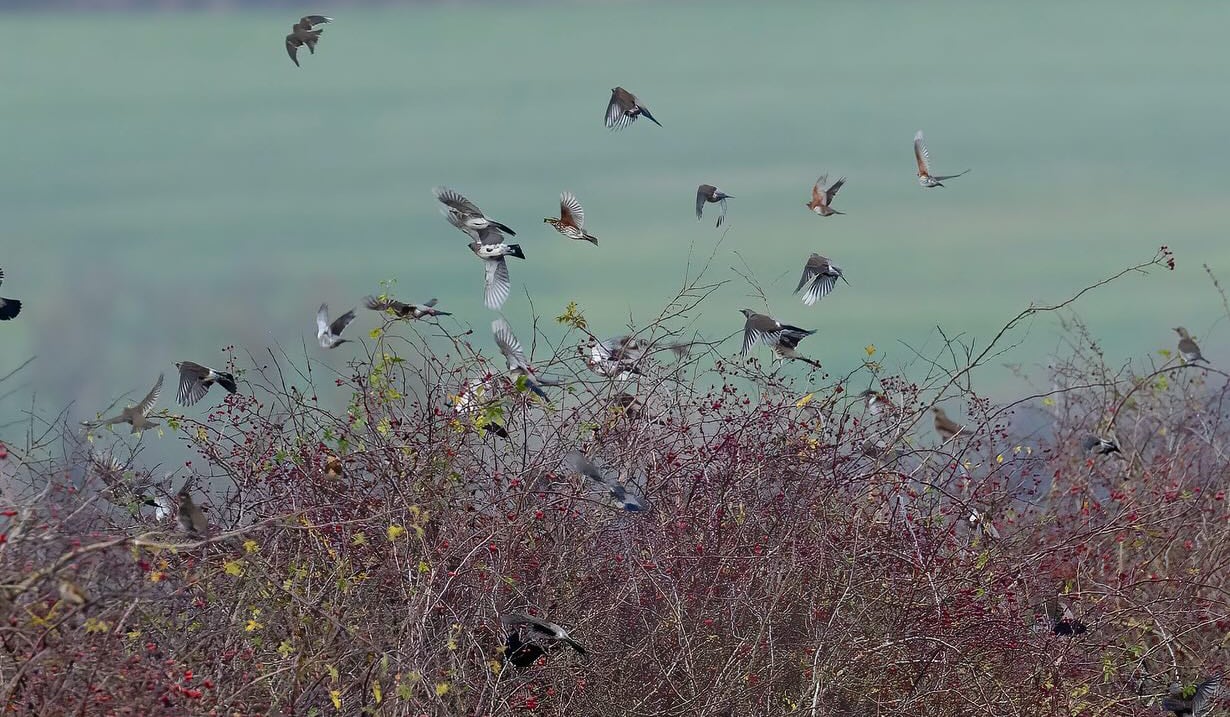- Home
- Written by Wrendale
- On the farm with Wrendale - Autumn's changing landscape
On the farm with Wrendale - Autumn's changing landscape

As we are now firmly into Autumn, the farm has begun its wintry metamorphosis. The verdant greens of summer are shifting to golds and reds and berries glisten amongst the hedgerows like rubies. Our summer visitors, such as chiffchaffs, swallows and warblers are making their long journeys to find warmer temperatures and we are just starting to see our winter migrants arriving in larger numbers.
 Swallow
Swallow
 Chiffchaff
Chiffchaff
During the next few months, we will expect to host hundreds of birds that arrive on our coastline from Scandinavia and the frozen north to enjoy our relatively mild winter. Amongst them will be members of the thrush family – song thrushes, blackbirds and mistle thrushes will join our native populations while new visitors, fieldfares and redwings will arrive to enjoy a smorgasbord of berries in our hedgerows.
Fieldfare
One of the challenges we have always faced on our farm is its difficult relationship with water. It would once have been a thriving complex of wetland and marshes, hosting a huge abundance and diversity of different species that rely on wetland habitat.
 Photograph of the wetlands on the farm in Spring
Photograph of the wetlands on the farm in SpringOver the past couple of centuries, many successive attempts have been made to drain the land to make it suitable for farming and it is crisscrossed with a network of land drains sitting under the surface that shift water underground and away from the farm through a system of straight dykes. Unfortunately, our heavy clay soil is much less suitable for farming than nutrient-rich soils in other areas of the country and we are in the unfortunate position that the land is still too wet to farm effectively, the clay holding on to water in the winter, but the drainage has also destroyed the wildlife rich wetlands that it once supported and in the summer, the water disappears completely, the clay soil baking hard and dry.
Photograph of the hard and dry clay soil in Summer
Over the past summer, we have been doing our best to disrupt some of the old drainage, bringing the water back to the surface and starting the process of restoring the wetland. The beavers are already playing a major role in this, damming streams of water that flow through the land to create ponds, pools and damp areas.
Beaver
As the autumn rains started to fall, the land has become wetter and it’s really satisfying to see pools and ponds starting to form, stretching across the farm. It really is incredible to see how quickly nature responds when you start to restore habitat – within days of the first big rainfall at the end of summer, dragonflies were laying eggs in the pools that had begun to form and we are now seeing huge numbers of snipe gathering on the farm. Snipe is a resident wetland bird that is joined by migrants throughout the winter. Its numbers have suffered significant long term declines due to loss of its wetland habitat across the country. In one small area of the farm this week 49 snipe were recorded as well as several jack snipe, a smaller and less common bird.
Jack Snipe
Time will tell whether the work we have done on the drains will mean that our wetlands will remain wet as the seasons change or whether there is more work to be done – we are at the start of a long journey but it’s incredibly satisfying to see the proliferation of these beautiful wetland birds returning to the farm this year.
Photography credits for this blog go to the wonderful Graham Catley.
want to KEEP UP WITH UPDATES ON THE FARM?
Click here to follow Wild Wrendale on social media.
Subscribe to our Newsletter
Archive
- July 2025 (1)
- May 2025 (2)
- April 2025 (2)
- March 2025 (5)
- February 2025 (1)
- January 2025 (3)
- December 2024 (2)
- November 2024 (1)
- October 2024 (1)
- September 2024 (3)
- August 2024 (1)
- July 2024 (2)
- June 2024 (2)
- May 2024 (5)
- April 2024 (3)
- March 2024 (3)
- February 2024 (5)
- January 2024 (3)
- December 2023 (6)
- November 2023 (4)
- October 2023 (3)
- September 2023 (4)
- August 2023 (5)
- July 2023 (4)
- June 2023 (4)
- May 2023 (2)
- April 2023 (6)
- March 2023 (5)
- February 2023 (3)
- January 2023 (5)
- December 2022 (4)
- November 2022 (3)
- October 2022 (3)
- September 2022 (4)
- August 2022 (5)
- July 2022 (2)
- April 2021 (3)
